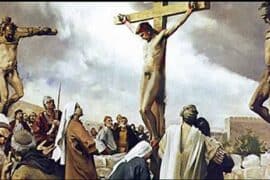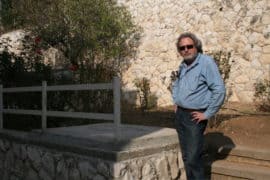For Christian believers, general readers, and scholars alike the most dramatic and riveting section of our N.T. Gospels is the “Passion Narrative,” found in three versions in the Synoptics (Mark, Matthew, Luke), as well as in the gospel of John. Whether John’s Gospel offers an independent version of the narrative is a sharply disputed point among the scholars. When Dom Crossan recently addressed my students in Jerusalem he began his talk on “The Last Days of Jesus” with that very question, one he considers to be absolutely fundamental to any historical reconstruction. Is John’s account simply an edited expansion of the core account we have in Mark, our earliest gospel, or is it an independent production? Crossan is convinced that John is simply recasting Mark, just as Matthew and Luke do, taking out things here and there, expanding in other places, with each contributing their own theological perspectives and emphases relevant to their times and to the tradition and communities from which they come.

I have struggled with this question for years and my conclusion is different from that of Crossan. Although the final editors of John are likely aware of Mark, the core narrative of John offers an independent account based on materials and testimony the authors (the “we” of John 21:24) attribute to the mysterious unnamed “disciple whom Jesus loved,” who only shows up at the “last supper” and appears again at the crucifixion, the empty tomb, and up on the Sea of Galilee when the disciples had returned to their fishing (John 21:24; 13:23; 19:26; 20:2; 21:7 & 20). To what degree this source, independent of Mark, runs through earlier sections of John, is a larger and more complex question that I can not address here, though in general my sense is that the narrative and chronological materials are more likely from this source, and perhaps the “Signs Source” as well, while the extended discourses of Jesus, with the distinct theology, style, and tone we see also reflected in the letters of 1, 2, and 3rd John, are overlaid on this more primitive source. In terms of the Last Days of Jesus that would mean that the “red letter” material that runs so extensively through John 13-17 has little if any connection to the historical Jesus.
I am convinced that the narrative and chronological framework that runs through John 12-20 (the appendix in chapter 21 is a separate matter) is not only independent of Mark 11-16 but is also based on traditions that are earlier and that developed outside of, and independently from, what became the “standard story,” as represented in Mark. Indeed, I think it is possible, though I only offer this as an explorative suggestion, that Mark “knows” something like the underlying narrative tradition now reflected in John and that he not only makes use of it but offers his own corrective overlay in places. In other words, maybe a more interesting question is not whether John knew Mark, but whether Mark knew “John”—or at least a primitive version thereof. In other words, Mark’s priority, which I accept, does not necessarily indicate primacy—particularly when it comes to the final days of Jesus.
What I want to do in this essay is simply highlight some of the more interesting materials we get from John, none of which are found in Mark, and some of which offer an alternative, or even contradictory, view of the Last Days of Jesus.
1. Mark knows that Jesus headquarters his movements during his last week at Bethany (11:1, 11-12; 14:3), the little village on the backside of the Mt. of Olives, but John provides the connection with the sisters Mary and Martha and their brother Lazarus, who lived there (John 11:1; 12:1). Mark never mentions this family though Luke, in an oddly placed story in his special section “on the road to Jerusalem (Luke 9:51-18:14), tells us how Mary chose to sit at the Teacher’s feet while Martha complained that she should be helping with the serving (Luke 10:38-42). He does not say “the certain village” where this took place was Bethany, and indeed, both the chronology and the geography of Luke show that he has no idea where it might have been (they are not even to Jericho in his narrative, much less near Jerusalem and the Mt. of Olives). In the gospel of John the raising of Lazarus from the dead is a critical point in the story and it not only accounts for the huge crowds that flocked around Jesus, having heard of the miracle, but also the sharp opposition of the Temple establishment (see John 12:9-11, 17-19). Mark knows nothing of this event or this family.
2. John says that the woman who anointed Jesus with a costly perfume was indeed Mary of Bethany, sister of Martha and Lazarus, and that she wiped his feet with her hair, a decidedly shocking and intimate act in that hair was considered part of “nakedness” (John 12:1-8). He explicitly says this took place six days before Passover. John adds other details, not in Mark, of how the house was filled with the scent of the fragrance, and that Judas, who objected to the “waste,” served as treasurer for the group and used to pilfer funds. Mark has an anonymous woman; he puts the scene two days before Passover, in Bethany, but at another house, of one “Simon the Leper,” and has only the anointing of the head and nothing about wiping the feet with her hair (Mark 14:3-9). Either he knows nothing of the sisters Mary and Martha and their brother Lazarus, or he is quite interested in writing them out of the story. One very odd feature of Mark is that even though he gives no name for this woman, he nonetheless insists that her story will be told throughout the whole world “in memory of her.” That surely is taking the motif of the anonymity of an important woman to the hilt.
Until just recently I had leaned toward giving Mark’s account of the anointing priority, but I am beginning to question my judgment in that regard. The two stories we have of the sisters “Mary and Martha,” come from independent sources (Luke’s “L” material and John) and both stress the intimacy and closeness of Mary to Jesus, as well as her status as “learner” or disciple, sitting at his feet. Also, in John there is a critical difference regarding the meaning of the anointing itself. In Mark, Jesus says that the unnamed woman has “anointed my body before hand for burying,” but in John he says she should keep the costly ointment to use for his body on the day of his burial, which is quite a different idea (John 12:7). That leads one to think, immediately, of the women coming early Sunday morning to the tomb to anoint the body of Jesus for burial in Mark, and Mary Magdalene coming alone to the tomb very early before the sun was even up in John (Mark 16:1; John 20:1). I have considered the possibility, suggested by others, that the figures of Mary of Bethany and Mary Magdalene are confused and conflated in our early gospel traditions just as they are in subsequent texts such as the Acts of Philip (see Which Mary, edited by F. Stanley Jones). I am no longer convinced that Mark should be given priority and that John is derivative in this regard.
I might note here that the fragments of the so-called “Secret Gospel of Mark” that Morton Smith found embedded in what I take to be an authentic letter of Clement of Alexandria, does contain the following passage about Lazarus of Bethany and his sisters. Whether this was original to Mark or not is disputed but I would strongly doubt such is the case:
“And they come into Bethany. And a certain woman whose brother had died was there. And, coming, she prostrated herself before Jesus and says to him, ‘Son of David, have mercy on me.’ But the disciples rebuked her. And Jesus, being angered, went off with her into the garden where the tomb was, and straightway a great cry was heard from the tomb. And going near, Jesus rolled away the stone from the door of the tomb. And straightaway, going in where the youth was, he stretched forth his hand and raised him, seizing his hand. But the youth, looking upon him, loved him and began to beseech him that he might be with him. And going out of the tomb, they came into the house of the youth, for he was rich. And after six days Jesus told him what to do, and in the evening the youth comes to him, wearing a linen cloth over his naked body. And he remained with him that night, for Jesus taught him the mystery of the Kingdom of God. And thence, arising, he returned to the other side of the Jordan.”
3. The last night of Jesus’ life John narrates a “last supper” scene that is clearly not the Jewish Passover Seder (13:1). It is a fellowship meal between Jesus and his disciples at which he offers them parting words of encouragement, anticipating his ordeal ahead, washing their feet as an example of service, and telling them about his forthcoming betrayal. In John it is clear that the Passover Seder is the following night (18:28). In Mark Jesus sits down with his disciples to “eat the Passover” (Mark 14:12-16). John mentions no sacred meal of bread and wine, which is the central feature of Mark’s account. In fact, everything that John narrates takes place “before the Passover” and “after supper,” so that the meal itself is deemphasized completely, in contrast to Mark.
Here we have two starkly contrasting traditions regarding Jesus’ last meal with his disciples and although various attempts have been made to harmonize the accounts I think it is clear that John is not offering an edited version of Mark but rather an alternative and independent account. It is worth noting that in our earliest written record of this “last supper,” found in Paul’s letter to the Corinthians, we are told that it took place “on the night he was betrayed,” with no explicit mention of Passover per se (1 Corinthians 11:23). Paul understands Jesus to be slain as a Passover lamb (1 Corinthians 5:7), which means his chronology fits more with John’s, who has the crucifixion on the afternoon of the 14th of Nisan, with the Passover lamb eaten as part of the Seder meal that evening. It is common for scholars to discount the Passover week chronology of John as part of his theological agenda to portray Jesus as a slain Passover lamb, but in fact, there are enormous historical problems with imagining Mark’s scenario. It is quite inconceivable that Jesus’ Jewish enemies left their Passover Seders and their family gatherings the night of Passover in order to arrest Jesus after midnight, try him before the High Priest and Pilate, and crucify him the next morning, which would be a holy annual Sabbath Day, the 1st Day of Unleavened Bread, the 15th of Nisan, when nothing of the sort could possibly be done (Exodus 12). Mark’s account simply makes no sense in any Jewish context and even he notes the “rush” to get Jesus arrested and killed before Passover, and the “bread” he mentions is not “unleavened,” even though he says they sat down to eat the Passover (Mark 14:2, 16, 22).
When it comes to matters of chronology and many historical details I am convinced that the authors of John are relying on traditions not only independent of Mark, but closer to the testimony of the one they claim was their “eyewitness” (John 21:24). These scenes of the “last supper” are a good case in point. Their essential framework fits well with what we know of Jewish custom and calendar, despite the heavily overlaid theological discourses put in the mouth of Jesus in these chapters (John 12-17).
4. John’s account of the arrest and trial is heavily colored by theological motifs. For John the “agony” of the scene is removed, and Jesus is so triumphant that his captors fall backward when they first see him. Characteristically, however, John supplies details that demonstrate that he is drawing upon an alternative tradition, not just pulling things from Mark and embellishing them:
a. The garden where Jesus is arrested is across the ravine called Kidron
b. A cohort of Roman troops is involved in the arrest, including the chiliarch, who was their commander.
c. The name of the servant of the High Priest whose ear was cut off was Malchus.
d. Jesus was taken first to Annas, the father-in-law of Caiaphas the High Priest. John alone reports this detail but it fits the historical situation based on what Josephus, the Jewish historian, tells us. It was Annas who really ran things behind the scenes and Caiaphas clearly was under his bidding. Mark knows nothing of Annas and never even mentions him. It was in the courtyard of the house of Annas that Peter got in through the gate because the “other disciple,” elsewhere called “the beloved disciple,” was known to the servants of the High Priest. This indicates that whoever this mysterious “Beloved Disciple” was, he had Jerusalem priestly connections.
e. Jesus is brought before Pilate at the praetorium, which was part of Herod’s palace on the western side of the city. The Jewish crowd stands outside, on the steps that are still visible today. They are not willing to come inside because they have already completed the ritual requirements for eating the Passover Seder that evening. Pilate questions Jesus inside, has him scourged, and allows the soldiers to mock him with the crown of thorns and the purple robe. Pilate would have stood at his canopy-covered Bema on the bedrock platform above the crowd that was called in Aramaic, Gabbatha, or the pavement., exposed today (See the brilliant account of Shimon Gibson, The Final Days of Jesus, pp. 81-106 on the archaeology of this area). Jesus had been taken inside the palace grounds, then back outside. John’s description reflects someone who knows the place and the scene, while Mark simply says “they delivered him up to Pilate” (Mark 15:1). John also notes that it was the “day of the preparation for the Passover,” at “the sixth hour,” (perhaps as late as noon), by the time Jesus was delivered over, not the day after as in Mark (John 19:14)
5. John provides several interesting and important details regarding the crucifixion and burial of Jesus that I do not think are merely embellishments of Mark. Once again, John’s Passion Narrative seems to be drawn from an alternative source.
a. The place of crucifixion was “near the city” and nearby was a garden (John 19:20, 41)
b. Jesus’ mother was present at the execution scene, and also the “disciple whom Jesus loved,” otherwise unmentioned in Mark who says that all the disciples “forsook him and fled” (John 19: 25-27; Mark 14:50).
c. The Sabbath that was arriving was a “high day,” or Nisan 15th, the 1st day of Unleavened Bread, that introduced the Passover (John 19:31).
d. Jesus’ side was thrust through with a Roman spear to assure he was dead and not just passed out or in a coma (John 19:34).
e. The tomb into which Joseph of Arimathea hastily put Jesus’ corpse was one that just happened to be in the garden near the place of crucifixion. It was a new tomb, not belonging to Joseph, but used temporarily by him in an emergency situation with the Passover Seder hours away, simple because it was “nearby” (John 19:41-42). One would expect, accordingly, that the body would be moved the next evening, just as soon as the Sabbath was over, so that the burial rites could be properly completed. Mark knows none of these details.
c. Mary Magdalene came alone to the tomb early Sunday morning, while it was dark. There is no indication that any of the other women were with her, as Mark has it, grouping them together for a single visit, after sunrise. When she arrived she saw that the golal, or blocking stone, had been removed from the entrance. She sees no one in the tomb, neither a young man (Mark), nor angels ascending from heaven (Matthew & Luke). She ran to Peter and the beloved disciple and told them the obvious: “They have taken away the Master out of the tomb and we do not know where they have laid him.” The “they” in this case clearly refers to Joseph of Arimathea and those who had taken charge of the burial.
Based on this material I am convinced that the authors of John are drawing upon a source independent from Mark and that this source should be carefully considered for its historical value. This is very much like Luke’s special material that is not taken from Q or from Mark. For example, it is only Luke that tells us that Jesus is sent by Pilate to Herod Antipas, who is in town for the festival, once Pilate learns he is a Galilean. When Luke is editing Mark’s account, which he does quite heavily, it is obvious, but when he is providing independent materials from his own tradition they can be quite helpful in terms of filling out the picture.
Scholars who do critical work on the gospels are often criticized for arbitrarily “picking and choosing,” of sources, but such is decidedly not the case with the kind of disciplined method of which Crossan and a host of “historical Jesus” scholars make use. One’s method is everything and I am convinced that recognizing the independence of the material embedded in John in an important step in sorting out the sources both in terms of chronology and dependence.









Comments are closed.